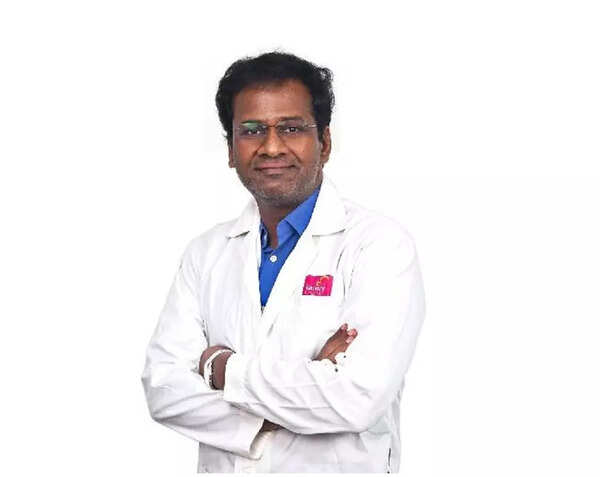Rheumatology
is a medical subspecialty that deals with bone, joints and
connective tissue disorders
. Most of these disorders are autoimmune .i.e an individual’s immune system affects his/her tissues and organs. Rheumatologists are physicians managing these types of disorders with medicines, injections and exercises. In simple terms – for all bone and joint pains which are not due to trauma, we have to consult a
rheumatologist
.
Common diseases treated:
1. Rheumatoid
arthritis
(RA)
2. Ankylosing spondylitis/Spondyloarthritis
3. Psoriatic arthritis
4. Gout
5. Osteoporosis
6. Osteoarthritis
Less common diseases treated:
1. SLE (Systemic lupus erythematosus/Lupus)
2. Systemic sclerosis/Mixed connective tissue disease
3. Sjogren’s syndrome
4.
Vasculitis
(eg: Takayasu’s arteritis, ANCA vasculitis etc.)
5. Sarcoidosis
When to visit a Rheumatologist?
1. Pain and/or early morning stiffness in multiple joints (rheumatoid arthritis)
2. Low back pain and early morning stiffness (Spondyloarthritis)
3. Any non-traumatic bone or joint pain
4. High uric acid with joint pains (gout)
5. Fracture after a trivial or minor fall (fracture due to osteoporosis)
6. Young females with fever, joint pains, oral ulcers, excessive hair loss (Lupus/SLE)
7. Non-healing ulcer in legs (Vasculitis)
8. Recurrent red eye or eye inflammation
9. Dry mouth and dry eyes (Sjogren’s syndrome)
10. Color change (white/blue) in fingers on cold exposure (Raynaud’s phenomenon)
11. Recurrent miscarriages/recurrent blood clots (antiphospholipid antibody syndrome)
Which are the two most common types of arthritis?
Osteoarthritis is the commonest type; due to ageing the cartilage (cushion like structure between two bones) undergoes wear and tear. The joint pain due to osteoarthritis worsens with activity and improves with rest.
Rheumatoid arthritis is the next common type, but the commonest among inflammatory arthritis. Here, the pain is more at rest and after a period of inactivity and improves with rest. That’s why, anyone with morning stiffness (after resting the whole night) with or without swelling in hand/foot joints or spine should consult a rheumatologist to rule out rheumatoid or spondyloarthritis.
A few myths and facts about arthritis and bone health:
Rheumatoid arthritis is chronic and patients have to suffer due to pain throughout their life.
No, early detection and prompt initiation of treatment alleviated all the symptoms and patients can have a good quality of life. Patients can be pain-free without any painkillers or steroids.
Painkillers and steroids are the only treatment options for rheumatoid arthritis.
No, painkillers or steroids are only temporary pain relievers. Many times, they are given for the initial 2-3 months because the conventional medicines for RA take 8-12 weeks to start acting.
But, we have newer medicines like JAK inhibitors (oral drugs) and biologics (injections) which have a faster onset of action and better control of inflammation.
So with proper usage and titration of appropriate RA medicines, patients can say ‘NO TO PAIN KILLERS OR STEROIDS’
There is no cure for Rheumatoid arthritis
Yes, currently there is no permanent cure for RA. But, early detection and treatment can lead to drug free remission in a few (disease goes to sleep and remains silent).
New trials with newer drugs and other futuristic therapies have been promising with chances of cure/prevention for autoimmune diseases.
RA affects only joints
No, RA is a systemic problem. If not controlled can lead to joint deformity and can involve other organs like eyes, lungs, blood vessels, heart etc.
The elderly break their bones due to aging, it’s natural
No, at any age breaking a bone (fracture) from a trivial fall (fall from a standing or walking height) is due to OSTEOPOROSIS. A simple screening test called DEXA SCAN and proper clinical risk assessment can lead to early detection of osteoporosis and all fragility fractures are preventable to a major extent.
Unlike arthritis, connective tissue diseases (SLE/LUPUS, Myositis), Vasculitis, etc. are complicated diseases with more chances of organ-threatening or life-threatening manifestations.
Yoga and/or exercises play a major role in management of arthritis.
Adequate sleep, healthy diet (more of vegetables, fruits, milk products, sunlight (except in Lupus) with less carbohydrates, high sugars and red meat) are equally important along with physical activity.

Dr. Sham from Kauvery Hospital Alwarpet is a distinguished Rheumatologist with 13 years of specialised experience in managing autoimmune and rheumatic diseases. His areas of expertise encompass Rheumatoid Arthritis, Systemic Lupus Erythematosus (SLE), Psoriatic Arthritis, and Vasculitis. He has received advanced training in Musculoskeletal Ultrasound from prestigious institutions in the United Kingdom and Italy. Currently, Dr. Sham serves as the Associate Editor for both the Indian Journal of Rheumatology and the Journal of Royal College of Physicians of Edinburgh. Alongside his clinical practice, he has a fervent interest in medical teaching, regularly organising Continuing Medical Education (CME) programs for students and healthcare professionals.
Disclaimer: The views and opinions expressed in the story are independent professional judgment of the experts and we do not take any responsibility for the accuracy of their views. This should not be considered as a substitute for medical advice. Please consult your doctor for more details. Kauvery Hospital is solely liable for the correctness, reliability of the content and/or compliance of applicable laws. The above is non-editorial content and TIL does not guarantee, vouch or endorse any of it. Please take all steps necessary to ascertain that any information and content provided is correct, updated, and verified.












 English (US) ·
English (US) ·